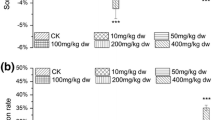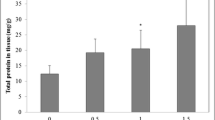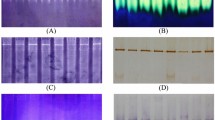Abstract
Colistin is a peptide antibiotic widely used as a feed additive in animal farming, especially in poultry and swine production, for treatment and prevention of gram-negative bacterial infections, as well as for growth promotion use. When orally ingested, colistin is poorly absorbed and is eliminated almost unaltered by the enteric canal into the environment. Thus, risk of environmental toxicity cannot be ignored. In the present study, we examined the effects of colistin on Heath Shock Protein (HSP) 70, metallothionein (MT) gene expressions, and the ultrastructure of intestinal cells, following treatment of the soil indicator earthworm Eisenia fetida with 10, 20, and 100 mg/kg colistin for 7, 14, and 21 days. The results showed that, compared with the control, the expressions of HSP70 and MT genes changed significantly. Colistin caused up-regulations of HSP70’s expression while inhibited the expression of MT gene. In addition, most mitochondria and endoplasmic reticulum were damaged in the group treated with high concentration. The investigation of gene expressions of HSP70 and MT, as well as pathological alterations in the intestinal cells, may provide important information in terms of ecotoxicity of colistin and can be used as early warning system.


Similar content being viewed by others
References
Andrews GK (2000) Regulation of metallothionein gene expression by oxidative stress and metal ions. Biochem Pharmacol 59:95–104
Bressan CR, Schmidell W, Soars HM (2013) Toxicity of the colistin sulfate antibiotic used in animal farming to mixed cultures of nitrifying organisms. Water Air Soil Pollut 224:1441
Callens B, Persoons D, Maes D, Laanen M, Postma M, Boyen F (2012) Prophylactic and metaphylactic antimicrobial use in Belgian fattening pig herds. Prev Vet Med 106(1):53–62
Cara JB, Aluru N (2005) Food deprivation induces HSP70 and HSP90 protein expression in larval and gilthead sea bream and rainbow trout. Comp Biochem Physiol B 142:426–431
Casal J, Mateu E, Mejia W, Martin M (2007) Factors associated with routine mass antimicrobial usage in fattening pig units in a pig-density area. Vet Res 38(3):481–492
Chen B, Wang JF (2000) Chronic valproate treatment increases expression of endoplasmic reticulum stress proteins in the rat cerebral cortex and hippocampus. Soc Biol Psychiat 48:658–664
Coyle P, Philcox JC, Carey LC, Rofe AM (2002) Metallothionein: the multipurpose protein. Cell Mol Life Sci 59:627–647
Dabrio M, Rodriguez AR, Bordin G, Bebianno MJ (2002) Recent development in quantification methods for metallothionein. J Inorg Biochem 88:123–134
Dai C, Li J (2012) Electrophysiology and ultrastructural changes in mouse sciatic nerve associated with colistin sulfate exposure. Toxicol Mech Methods 22(8):592–596
Dai C, Li J (2013) New insight in colistin induced neurotoxicity with the mitochondria dyfunction in mice central nervous tissues. Exp Toxicol Pathol 65:941–948
Dai C, Zhang D (2013) Effect of colistin exposure on calcium homeostasis and mitochondira functions in chick cortex neurons. Toxicol Mech Methods 23(4):281–288
Dallinger R (1996) Metallothionein research in terrestrial invertebrates: synopsis and perspectives. Comp Biochem Physiol 113:125–133
Edwards CA (2004) Earthworm Ecology, 2nd Edn. CRC Press, Boca Raton, FL, USA. EMEA. Colistin—summary report (EMEA/2002/MRL/016/95-Final), 6
Galay-Burgos M, Spurgeon DJ (2003) Developing a new method for soil pollution monitoring using molecular genetic biomarkers. Biomarkers 8:229–239
Homa J, Sturzenbaum S, Morgan A, Plytycz B (2007) Disrupted homeostasis in coelomocytes of Eisenia fetida and Allolobophora chlorotica exposed dermally to heavy metals. Eur J Soil Biol 43:S273–S280
Hund-Rinke K, Wiechering H (2001) Earthworm avoidance test for soil assessment. J Soils Sediments 1:15–20
Kiang JG, Tsokos GC (1998) Heat shock protein 70 kDa: molecular biology, biochemistry, and physiology. Pharmacol Ther 80:183–201
Kotani M, Hyun Kim K, Ishizaki N (2013) Magnesium and calcium deficiencies additively increase zinc concentrations and metallothionein expression in the rat liver. Br J Nutr 109:425–432
Li J, Nation RL, Milne RW, Turnidge JD, Coulthard K (2005) Evaluation of colistin as an agent against multi-resistant gram-negative bacteria. Int J Antimicrob Agents 25:11–25
Liu W, Zhou QX (2003) 1, 2, 4-trichlorobenzene induction of chromosomal aberrations and cell division of root-tip cells in Vicia faba seedlings. Bull Environ Contam Toxicol 71:689–697
Livak KJ, Schmittgen TD (2001) Analysis of relative gene expression data using real-time quantitative PCR and the 2-[Delta][Delta] CT method. Method 25:402–408
Mori K (1999) Cellular response to endoplasmic reticulum stress mediated by unfolded protein response pathway. Tanpakushitsu kakusan koso 15(44): 2442–2448
Morimoto RI (1993) Cells in stress: transcriptional activation of heat shock protein genes. Science 259:1409–1410
Nadeau D, Corneau S (2001) Evaluation for HSP70 as a biomarker of effect of pollutants on the earthworm L. terrestris. Cell Stress Chaperones 6:153–163
Padmini E, Rani MU (2008) Impact of seasonal variation on HSP70 expression quantitated in stressed fish hepatocytes. Comp Biochem Physiol B 151:278–285
Pirooznia M, Gong P, Guan X (2007) Cloning, analysis and functional annotation of expressed sequence tags from the earthworm Eisenia fetida. BMC Bioinforma 8:1–16
Reichert A, Neupert W (2002) Contact sites between the outer and inner membrane of mitochondria-role in protein transport. Biochim Biophys Acta (BBA) Mol Cell Res 1592:41–49
Ricketts HJ, Morgan AJ, Spurgeon DJ (2004) Measurement of annetocin gene expression: a new reproductive biomarker in earthworm ecotoxicology. Ecotoxicol Environ Saf 57:4–10
Sarkar S, DeSantis ERH, Kuper J (2007) Resurgence of colistin use. Am J Health Syst Pharm 64(23):2462–2466
Sauve S, Hendawi M (2002) Phagocytic response of terrestrial and aquatic invertebrates following in vitro exposure to trace elements. Ecotoxicol Environ Saf 52:21–29
Schroder M, Kaufman RJ (2005) ER stress and the unfolded protein response. Mutat Res 569:29–63
Shi-jin W (2012) Effects of 1, 2, 4-trichlorobenzene on the enzyme activities and ultrastructure of earthworm E. fetida. Ecotoxicol Environ Saf 76:175–181
Simonsen V, Scotte FJJ (2004) Genetic variation in the enzyme esterase, bioaccumulation and life history traits in the earthworm Lumbricus rubellus from a metal contaminated area, Avonmouth, England. Ecotoxicity 13:773–786
Sorour J, Larink O (2001) Toxic effects of benomyl on the ultrastructure during spermatogenesis of the earthworm Eisenia fetida. Ecotoxicol Environ Saf 50:180–188
Spurgeon DJ, Svendsen C (2003) Quantifying copper and cadmium impacts on intrinsic rate of population increase in the terrestrial oligochaete Lumbricus rubellus. Environ Toxicol Chem 22(7):1465–1472
Svendsen C, Spurgeon DJ (2004) A review of lysosomal membrane stability measured by neutral red retention: is it a workable earthworm biomarker? Ecotoxicol Environ Saf 57:20–29
Wenguang X, Ling B, Rizwan-ul-Haq M (2012) Molecular cloning, characterization of copper/zinc superoxide dismutase and expression analysis of stress-responsive genes from Eisenia fetida against dietary zinc oxide. Comp Biochem Physiol C 155:416–422
Acknowledgments
This research was funded by the Program for Changjiang Scholars and Innovative Research Team in University (no. IRT13063), Special Fund for the National Natural Science Foundation of China (project no.31172368), and the Guangdong Natural Science Foundation (project no: S2011010001090).
Author information
Authors and Affiliations
Corresponding author
Additional information
Responsible editor: Philippe Garrigues
Rights and permissions
About this article
Cite this article
Guo, R., Ding, X., Zhong, X. et al. Molecular and ultrastructural insights into the earthworm Eisenia fetida of the assessment of ecotoxicity during colistin exposure. Environ Sci Pollut Res 21, 13405–13411 (2014). https://doi.org/10.1007/s11356-014-3256-2
Received:
Accepted:
Published:
Issue Date:
DOI: https://doi.org/10.1007/s11356-014-3256-2




